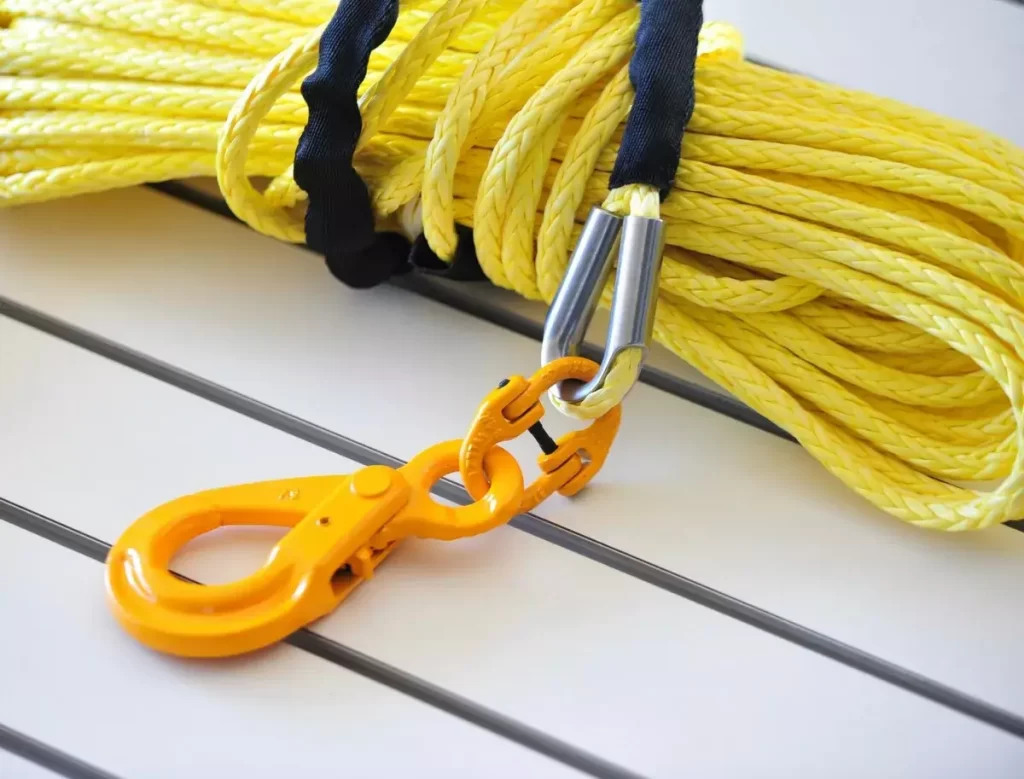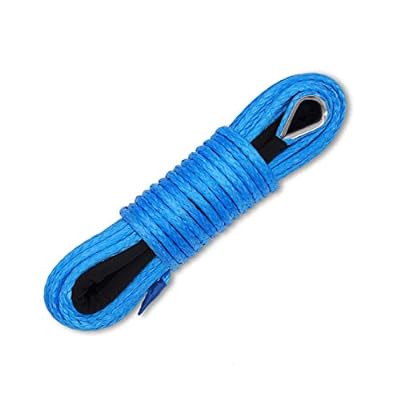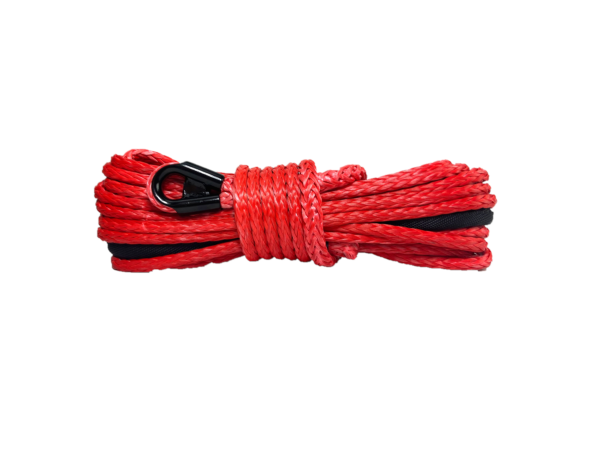One of the most critical components of a winch system is the rope, and choosing the right size is crucial for safe and effective operation.
In this guide, I’ll take an in-depth look at two common winch rope sizes: 3/16 inch and 1/4 inch, and help you determine which one is best suited for your needs.
Key Takeaway
- Vehicle Weight: Choose a rope that can safely handle your vehicle’s weight. Lighter vehicles may be fine with a 3/16 inch rope, while heavier vehicles require the stronger 1/4 inch rope.
- Intended Use: Assess how frequently and under what conditions you’ll use the winch. Light-duty, occasional use suits a 3/16 inch rope, whereas heavy-duty, regular use demands the durability of a 1/4 inch rope.
- Budget Considerations: While the 3/16 inch rope may be more budget-friendly upfront, the 1/4 inch rope could offer better long-term value due to its increased durability and reduced need for replacements.
- Safety Margins: Opt for a rope with a breaking strength well above your maximum anticipated load to ensure safety under all conditions.
- Balanced Decision: Weighing these factors will guide you to the most suitable winch rope size, ensuring optimal performance, safety, and value for your specific situation.
Understanding Winch Rope Specifications

Before diving into the specifics of 3/16 and 1/4 inch winch ropes, it’s essential to understand some key specifications that define a rope’s performance.
The breaking strength, measured in pounds or tons, is perhaps the most critical factor.
It represents the maximum load a rope can withstand before failing, and it’s directly related to the rope’s diameter – the thicker the rope, the higher the breaking strength.
However, breaking strength isn’t the only factor that affects a winch rope’s performance.
The material (typically synthetic fibers like Dyneema or Plasma), construction (braided or twisted), and other factors like abrasion resistance and stretch also play a role in determining a rope’s overall durability and suitability for specific applications.
Also check: Best Synthetic Winch Ropes
3/16 Inch Winch Rope

Let’s dive deeper into the 3/16 inch winch rope, a popular choice for many due to its balance of functionality and affordability.
Breaking Strength Range
The breaking strength of a winch rope is one of the most critical factors to consider.
For a 3/16 inch rope, this strength typically ranges between 4,000 to 6,000 pounds.
Breaking strength is the maximum load the rope can handle before it fails. This range makes the 3/16 inch rope suitable for lighter applications where the load doesn’t exceed these limits.
It’s essential to select a rope with a breaking strength that comfortably exceeds the maximum load you plan to apply to ensure safety and longevity.
Advantages
Lighter Weight
The 3/16 inch rope is relatively light, making it easier to handle and causing less strain on the winch mechanism.
This weight advantage makes the rope an excellent choice for those who prioritize ease of use and efficiency.
A lighter rope also means quicker and less labor-intensive deployment and retrieval, which can be crucial in challenging conditions or when speed is of the essence.
Easier Handling
Flexibility is another significant advantage of the 3/16 inch rope. This flexibility allows for simpler spooling and unspooling, making it more user-friendly, especially for those who are not professional operators.
The ease of handling can significantly reduce setup time and make the winching process smoother and less cumbersome.
Lower Cost
Cost is a critical factor for many, and the 3/16 inch rope generally comes in as a more budget-friendly option compared to its thicker counterparts.
Its lower price point makes it accessible to a wider audience, including casual users and those who need a winch rope for occasional use.
Disadvantages
Lower Breaking Strength
While the lighter weight and lower cost are attractive, these come at the expense of a lower breaking strength.
This makes the 3/16 inch rope less suitable for very heavy loads or extreme winching scenarios.
It’s important to assess the typical loads you expect to encounter and choose a rope that can handle those loads with a significant safety margin.
Less Durability
The thinner diameter of the 3/16 inch rope can also impact its durability. It may be more prone to wear, abrasion, and damage over time, especially when used in harsh conditions or over rough surfaces.
Regular inspection and careful handling can mitigate these issues to some extent, but it’s an important consideration for those expecting to use their winch rope frequently or in challenging environments.
Ideal Applications
Given its characteristics, the 3/16 inch winch rope is best suited for lighter vehicles, shorter pulls, and recreational use.
It’s ideal for situations where the demands on the rope are not exceedingly high, such as occasional vehicle recovery, moving light objects, or use with smaller, recreational off-road vehicles.
The rope’s advantages in weight, handling, and cost make it a suitable choice for these applications, provided that its limitations in breaking strength and durability are taken into account.
1/4 Inch Winch Rope

The 1/4 inch winch rope represents a step up in strength and durability from its thinner counterparts, designed to meet the demands of more challenging tasks.
This type of rope is engineered for those who need a reliable solution for heavier loads and more demanding applications.
Breaking Strength Range
With a typical breaking strength range of 8,000 to 10,000 pounds, the 1/4 inch winch rope is significantly stronger than the 3/16 inch variant.
This strength is crucial for applications where the loads are substantial, and the risk of breakage must be minimized.
The higher breaking strength provides a much-needed safety margin, ensuring that the rope can handle unexpected stresses without failing.
Advantages
Higher Breaking Strength
The primary advantage of the 1/4 inch winch rope is its ability to safely manage heavier loads.
This capability is essential for heavy-duty applications where the weight of the vehicle or the cargo demands a rope that can endure without risking safety or success.
Increased Durability
Thanks to its thicker diameter, the 1/4 inch rope offers enhanced durability.
It is more resistant to wear, abrasion, cuts, and UV damage, making it a better choice for users who frequently encounter harsh environments or need a winch rope that can last longer under rigorous conditions.
This durability also translates into a longer lifespan, reducing the need for frequent replacements and offering better long-term value.
Disadvantages
Heavier Weight
The increased strength and durability come with a trade-off in terms of weight. The 1/4 inch rope is heavier, making it more challenging to handle, especially for those not used to dealing with heavy-duty winch ropes.
This added weight can also put more strain on the winch motor and mounting hardware.
More Challenging Handling
Aside from the weight, the thicker diameter of the 1/4 inch rope makes it stiffer, which can complicate spooling and unspooling on the winch drum.
This stiffness requires more effort and attention during operation, making it less user-friendly than thinner ropes.
Ideal Applications
Given its robust characteristics, the 1/4 inch winch rope is perfectly suited for heavier vehicles, longer pulls, and heavy-duty applications.
It’s the go-to choice for off-road enthusiasts with larger vehicles who tackle challenging terrain or for commercial and industrial users who require a reliable winch rope for frequent, high-load applications.
The 1/4 inch rope’s strength and durability make it an ideal candidate for situations where failure is not an option, offering peace of mind and reliability when it’s needed most.
Comparison of 3/16 and 1/4 Inch Winch Ropes
When comparing 3/16 and 1/4 inch winch ropes, it’s essential to consider various factors that impact their suitability for different applications.
This comparison touches on key aspects like breaking strength, handling ease, weight differences, and cost considerations.
Breaking Strength
Breaking strength is a critical factor in choosing a winch rope. It determines how much load the rope can handle before it fails.
The 1/4 inch rope, with its typical breaking strength range of 8,000 to 10,000 pounds, is substantially stronger than the 3/16 inch rope, which usually ranges from 4,000 to 6,000 pounds.
This significant difference means the 1/4 inch rope is better suited for heavier loads and more demanding tasks, providing a higher safety margin and reducing the risk of rope failure under stress.
Handling Ease and Weight Differences
The diameter and weight of the rope directly affect its handling. The 3/16 inch rope is lighter and more flexible, making it easier to handle, spool, and unspool.
This ease of handling is especially beneficial for those who might not use their winch frequently or who prefer a rope that’s easier to manage during quick or less demanding pulls.
In contrast, the 1/4 inch rope, being thicker and heavier, can be more cumbersome to work with. Its increased weight and stiffness may pose challenges in handling, especially for those who are not accustomed to dealing with heavier-duty ropes.
Cost Considerations
Cost is an essential factor for many users. The 3/16 inch rope generally comes at a lower price point, making it a more budget-friendly option for individuals or applications where the highest breaking strength isn’t necessary.
However, it’s important to consider long-term value. The 1/4 inch rope, while initially more expensive, may offer better value over time due to its increased durability and longevity.
Investing in a thicker rope might mean fewer replacements and, ultimately, cost savings for those who use their winch rope heavily or in more challenging conditions.
Making the Right Choice
Choosing between the 3/16 and 1/4 inch winch ropes involves weighing these factors based on your specific needs.
If you prioritize ease of handling and lower cost for lighter-duty applications, the 3/16 inch rope could be the ideal choice.
It offers a good balance for recreational users or those with lighter vehicles.
On the other hand, if your focus is on maximizing safety and durability for heavier loads or more rigorous applications, the 1/4 inch rope stands out as the better option.
Its higher breaking strength and increased resilience make it suitable for heavier vehicles, challenging recoveries, or professional use where performance and reliability are paramount.
Choosing the Right Winch Rope Size
Choosing the correct winch rope size is more than just picking a rope that fits your winch; it’s about matching the rope to your specific needs, ensuring it can handle the loads you expect to encounter safely and efficiently.
Vehicle Weight
The weight of your vehicle is a fundamental factor in selecting a winch rope. Heavier vehicles exert more stress on the rope during recovery operations.
A rope with a higher breaking strength is necessary to accommodate this increased load. For instance, a light SUV or crossover might be well-served by a 3/16 inch rope for general use, but a full-size truck, which is significantly heavier, would require the added strength of a 1/4 inch rope to ensure that the rope can handle the vehicle’s weight, especially under challenging conditions.
Intended Use
How you plan to use the winch rope also plays a crucial role in the selection process. If your winching needs are primarily for light-duty applications, such as occasional pulls on relatively flat and forgiving terrain, a 3/16 inch rope might suffice.
However, for more demanding scenarios—like frequent recovery of heavy vehicles from mud, sand, or steep inclines, or for commercial applications where the rope is used regularly—a 1/4 inch rope with its higher breaking strength and durability becomes essential.
The intended use directly impacts the wear and tear on the rope, making it important to choose a size that won’t just survive but thrive under the conditions you anticipate.
Budget
Budget considerations cannot be overlooked, but they should be balanced against the need for safety and reliability. Initially, a 3/16 inch rope may appear more attractive due to its lower price point.
However, investing in a 1/4 inch rope might be more cost-effective in the long run, especially if you require a rope that can withstand heavier loads and more frequent use.
The durability of a thicker rope can translate into fewer replacements over time, ultimately saving money and ensuring you’re not caught without a reliable winch rope when you need it most.
Safety Margins
Safety should always be the top priority when selecting a winch rope. Opting for a rope with a breaking strength that exceeds your maximum anticipated load by a significant margin is critical.
This safety margin accounts for unforeseen stresses and ensures that the rope can handle the load even under less-than-ideal circumstances.
For example, if you anticipate needing to recover loads of up to 6,000 pounds, choosing a rope with a breaking strength of 8,000 to 10,000 pounds (like many 1/4 inch ropes offer) provides a buffer against unexpected complications or additional strain on the rope.
Also check: Synthetic Winch Rope vs Steel Cable
Conclusion
Choosing between a 3/16 inch and 1/4 inch winch rope comes down to balancing your specific needs and priorities.
3/16 inch ropes offer a lightweight, easy-to-handle, and cost-effective solution for lighter vehicles and moderate pulling tasks.
On the other hand, 1/4 inch ropes provide increased strength and durability, making them better suited for heavier rigs, longer pulls, and more demanding off-road situations.
Ultimately, the right choice will depend on factors like your vehicle’s weight, intended use, and budget.
However, it’s crucial to prioritize safety by selecting a rope with an appropriate breaking strength and maintaining a reasonable safety margin.
By following best practices for rope selection, use, and maintenance, you can ensure a safe and successful off-road experience, no matter which rope size you choose.

